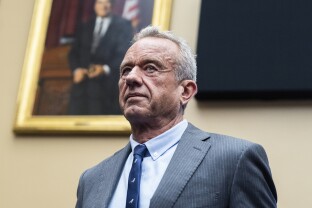The Department of Health and Human Services last month quietly announced its intention to fund the development of vaccines against two viruses it considers “material threats to national health security.”
It’s a sign that even as Health Secretary Robert F. Kennedy Jr. fires the country’s top vaccine committee and backs cuts to infectious disease research, the department is still aware of the dangers a hobbled public health infrastructure would pose to U.S. biosecurity.
The pre-solicitation notice for the two vaccines was posted to a government contracting website on June 27. It came from the Biomedical Advanced Research and Development Authority, an HHS center that partners with the biomedical industry to develop bioterrorism countermeasures. (BARDA is housed within the Administration for Strategic Preparedness and Response, which Kennedy announced would be reshuffled into the Administration for a Healthy America, although the status of the secretary’s planned department reorganization is hazy.)
“It’s almost notable in that it’s not remarkable at all,” one former ASPR official said of the announcement. “Maybe you give this administration some small bit of credit for not blowing everything up, or maybe BARDA managed to do this under the radar.”
“Maybe don’t write about it,” the former official jokingly suggested.
BARDA is aiming to target the Marburg virus and Sudan ebolavirus with the proposed vaccines. Both are hemorrhagic fevers in the same family as the Ebola virus. Hemorrhagic fevers are characterized by severe symptoms, including uncontrolled bleeding, and high fatality rates.
An HHS spokesperson said in an email to NOTUS after publication of this article that “BARDA plans to invest Project BioShield funds to support the advanced development and potential FDA licensure of monovalent vaccines” for the Marburg and Sudan viruses.
“These viruses cause deadly hemorrhagic fevers, and no FDA-approved vaccines or treatments currently exist,” the spokesperson wrote. “Eligible vaccine candidates must be in or have completed Phase 2 clinical trials. BARDA funding may support Phase 3 studies, CMC development, U.S.-based manufacturing, nonclinical studies, assay development, and post-marketing studies required for licensure. The acquisition also includes options for future dose procurement as needed.”
Phase 3 clinical trials are the final testing step drugs must complete before FDA approval, and they generally take several years.
Cases of hemorrhagic fevers are rare in the U.S., but Africa has seen outbreaks of the Marburg and Sudan viruses every few years for decades. The worst hemorrhagic fever outbreak to date was an Ebola outbreak in West Africa in the mid-2010s that infected over 28,000 people. More than 11,000 died.
But while two vaccines against Ebola are now commercially available, neither protect against the Marburg or Sudan viruses.
BARDA is currently funding Marburg and Sudan vaccines in development with the nonprofit Sabin Vaccine Institute. Both vaccines entered clinical trials in the U.S. earlier this year.
Gigi Kwik Gronvall, a professor at Johns Hopkins University and biosecurity expert, said via text that while hemorrhagic viruses could pose a biosecurity threat, she was far more concerned by the immediate threat posed by avian influenza. HHS recently cancelled funding for a candidate mRNA H5 avian influenza vaccine that was in development with Moderna.
“In an ideal world, we would do both because even though Marburg is not immediately important, it is a naturally occurring disease that is pretty devastating,” Gronvall wrote. “It’s preparing for that in advance of an actual crisis that biosecurity is all about.”
The Marburg and Sudan vaccines that BARDA is currently developing aren’t mRNA vaccines. Both use a technique called an adenovirus vector, which uses a modified version of a “common cold” virus to present proteins from the hemorrhagic viruses to the immune system and elicit an immune response.
While Kennedy has questioned the safety and efficacy of vaccines writ large, he has called special attention to the supposed dangers of mRNA vaccines, which were used to combat COVID-19.
Like the ASPR official, Gronvall wondered if the pre-solicitation announcement flew under Kennedy’s radar.
“It makes me wonder if this is something that was on auto pilot because they haven’t exactly been encouraging of science-based approaches to dealing with any public health threats, especially those of a viral nature,” Gronvall said.
—
Editor’s Note: This story was updated with additional reporting.
Sign in
Log into your free account with your email. Don’t have one?
Check your email for a one-time code.
We sent a 4-digit code to . Enter the pin to confirm your account.
New code will be available in 1:00
Let’s try this again.
We encountered an error with the passcode sent to . Please reenter your email.


